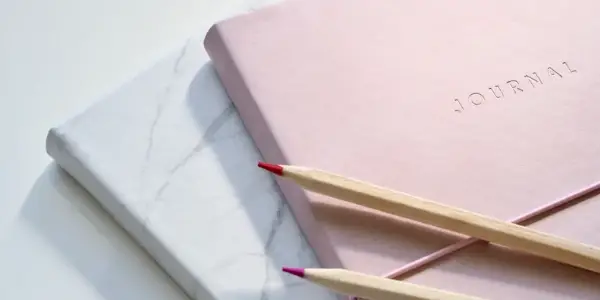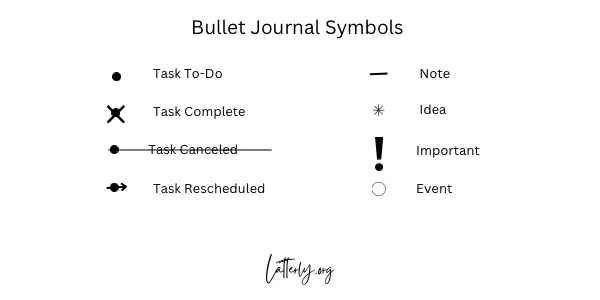Feeling stressed, disorganized, or unable to handle your to-do list? This bullet journal monthly calendar printable might be just the thing for you!
If you’re new to bullet journaling, you may be wondering what a bullet journal is. It’s a way to organize your entire life in one place.
In its simplest form, a bullet journal (also called BuJo for short) is the one place to keep all your most important information, including to-do lists, goals, daily habits, calendar appointments, important events, notes, and sketches.
Digital designer Ryder Carroll introduced the bullet journal in 2013, and it was an instant hit. Hundreds of thousands of people now call themselves bullet journalists, and for good reason.

They’re organizing their lives and activities, including work, home, birthday parties, vacations, weddings, homework, and just about anything else.
While being organized feels good, the real benefit of bullet journaling is taking the time to prioritize essential activities in your life. The process forces reflection as you set up each month and year.
Digital vs. Paper Journaling
Many wonder if they can use a digital planner instead of a paper bullet journal. The answer is that you can, but it likely won’t be as effective.
Writing and re-writing your lists connects ideas in your brain, challenges you to consider what items are needed, and commits them to memory as no digital process can.
Try using paper for a couple of months to see if it helps you get clearer and more focused.
Typical Bullet Journal Setup
Sections to Include in your Bullet Journal:
These are some examples of sections to include in your journal, but you’ll only use what suits you best.
Index
The journal starts with a four-page index so that you can find things later. The index is the most important section and is the one place you can see everything included in your journal.
List each section and the page number(s) the section is on. You keep a running list in your index, making each item easy to find later.
Future Log
The future log is a two-page spread where you note things you need to do or events you will attend in the next six to twelve months.
I section out two pages into six blocks each and write the next twelve months into the blocks. I then note any events or to-dos within the boxes, so I have them handy when I set up that month in the future.
Monthly Log/Monthly Spread
The monthly spread is the real workhorse of your bullet journal. You can keep track of calendar appointments and to-dos, track daily habits, big goals, or anything else important to you.
Bulletjournal.com recommends a monthly spread is two pages, with the calendar on the left page and the to-do list on the right side.
I like to include a mini calendar on my monthly spread to quickly glimpse the current month and the following month.
Weekly Log/Weekly Spread
Weekly spreads are sometimes used but are not necessary. They are the same as a monthly spread but are only for the week.
The weekly spread is for you if you want more frequent reflection and review.
Daily Log
The daily log is where you keep a running list of things you want to remember each day. I note things like to-dos (that I will move to my monthly spread later that night if not completed), events or appointments, and notes about what happened during the day.

Daily habit tracker
A daily habit tracker is an excellent way to hold yourself accountable for daily habits or practices you want to keep.
Some habits include water drinking, exercise log, meditation practice, affirmations, sleep goals, taking vitamins, stretching, or journaling.
Weekly habit tracker
I find it useful also to have a weekly habit tracker. Put things like your cleaning schedule, errands you run regularly, or anything else with more of a weekly cadence.
Goals
I put my goals on my monthly log, but many have different sections for annual or monthly goals. Put reading or writing goals, savings goals, things to learn, self-care goals, social goals, business goals, or anything else
Make it a daily or weekly habit to read your goals, so they are in the back of your mind.
Birthdays Page
I have a 2-page spread that looks just like my future log, except it’s for birthdays. I refer to this every month when setting up my monthly spread. It is so valuable – and I never forget important birthdays anymore.
Note: you could also do with anniversaries if you keep track of those.
Custom Collections
Custom collections are anything else you want to organize or track. For example, I have custom collections for my blog post ideas, Christmas shopping, and work-specific research topics.
Add the custom collection and pages to your index, and you’re ready to go.
Bullet Journal Symbols
You can make up any symbols you like using your bullet journal. I’ve tried several different methods, but I always go back to those similar to the recommended symbols on bulletjournal.com.

Bullet journal supplies
Notebooks
I use the journal sold by bulletjournal.com. With page numbers, dots, and over 200 pages, it includes the most critical elements. The hardcover and high-quality paper make it last.
Pens
You don’t need a fancy pen by any means — any pen or pencil will work.
Markers
Again, markers are not required, but I like to color code my calendar items so I can quickly see who is doing what each day (I have a large family).
Washi tape
Washi tape is a fun addition if you feel like getting artistic. You can use it to separate sections or make sections on pages.
Stickers
These stickers can make your bullet journal even more useful. I don’t have the best handwriting, so stickers take it up a level.
Stencils
I cannot draw straight lines or shapes, so stencils come in handy.
Putting it all together: How to use your bullet journal
Now that you know more about the bullet journal, it’s time to put it together.
The bullet journal setup is one of the most exciting parts.
Remember, the bullet journal is supposed to be flexible and fit your life, so there is no best way (other than the way that works for you).
This video from Bullet Journal gives the perfect introduction.
Now it’s time to use it!
Start by rapidly logging any critical items in your daily journal, including tasks, notes, and events. Use it to declutter your mind and keep track of essential items.
Mark tasks as complete if completed during the day, or cross them out if they become irrelevant.
Every evening, take a moment to reflect. Review your daily log, mark any tasks as complete, and refine/eliminate any tasks as needed.
Review the previous day’s daily logs in the morning, and set up today’s daily log. Also, check your monthly spread to see if any monthly to-dos or events need to be completed today.
At the end of each month, you’ll do a monthly reflection, which includes the following:
- Review the past month (both daily and Monthly pages) to find any open tasks that need to be completed in the next month.
- Check the future log to find any tasks or events in the following month.
- Reflect on the importance of each open task and event. Does each item matter when considering your overall life goals? Can anything be eliminated that isn’t significant or doesn’t matter?
- Set up the following month’s monthly spread. Migrate any open items that must be completed to the new month and set up your calendar.

Bullet journal transfer
When you have fully used your bullet journal, or when a new year comes, you’ll go through the process again of setting up the index, future log, custom collections, and monthly/daily spreads.
Transferring bullet journals is another excellent opportunity to reflect on what’s important and allow only things that matter into your life and schedule.
Try it out!
While I don’t see many bullet journals in my corporate workplace, I can’t help but think this tool would be beneficial to so many as they run from meeting to meeting and juggle projects.
I’ve gotten a lot out of the journal. Having had “get organized” on my New Year’s resolution list for the last 15 years (and many failed attempts to make it happen), I needed something to help me organize my life.
I spent many years being the last person to respond to a group text regarding an event, the first to forget something, and the one shopping for food to bring to a party at midnight the night before. The challenge to keep up is real!
I’ve tried many other planners and methods, but this is the one that works for me.
I think that the many daily check-ins are key. I review my bullet journal in the morning, log items during the day, and check it at night. It’s become a central part of my life that’s reduced my anxiety and increased my ability to identify critical tasks and get them done.
Finally, if you look at Pinterest or other bullet journals, you’ll see that artistic journalists have created works of art with their bullet journals.
However, don’t worry if you aren’t artistic! I have little to no creative talent, and my journal has been the most helpful tool. The goal is to use this tool to live your most productive life, where only the most important things make it to your to-do list.
Your future self with thank you.
Bullet journal monthly calendar printable
Now that you know how to put together a bullet journal, you may find it helpful to use some free printables or bullet journal templates to set up specific pages.
Get your bullet journal monthly calendar printable here.

